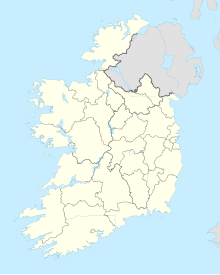Pollen analysis in Lough Sheeauns
Coordinates: 53 ° 33 '24 " N , 10 ° 4' 35" W.
The pollen analysis in Lough Sheeauns was carried out east of Cleggan in north-west Connemara in County Galway in Ireland . The lake has a diameter of about 100 m and lies in the middle of a concentration of Neolithic megalithic systems . A portal tomb is only 50 m from the lake shore. The locations of five other systems are shown within a radius of less than one kilometer.
Due to the proximity of prehistoric structures to the lake, it was assumed that the sediments contain information about the early activities. The study of the deposits actually provided clues as to the species composition, the age and duration of Neolithic agriculture and its effects on vegetation.
The pollen diagram presented a number of interesting features. Only a few grain pollen was recorded. The spread of grasses , plantain , bracken , dandelions , daisies and dock was striking . Their expansion corresponds to a decrease in pollen from oak , elm and hazelnut . The time scale of these processes is based on a sequence of data from the sediment and refers to the early Neolithic.
The population cleared the forest area near the lake. Small amounts of grain pollen show that grain production (the soil is not particularly suitable) played a smaller role in agriculture than assumed and, at least here, more animal husbandry, i.e. pastoral or transhumant agriculture, was practiced. It must be taken into account that the pollen from grain does not spread widely and is rather underrepresented. It was also of interest that coal particles or soot were not present in the sediment, so that slash and burn could be ruled out. In contrast, finds of charcoal on the peat-preserved early Neolithic dwelling near Ballynagilly , in County Tyrone , revealed evidence of slash and burn.
It is believed that the degeneration of the soil resulted in further clearing and the abandoned areas were grazed, so that reforestation was avoided. This created the possibility of a more semi-nomadic agriculture. This is clearly not the case at Lough Sheeauns. Heather and sedge , the usual signs of degeneration are not very numerous and the chemical characteristics of the sediment in the lake indicate no change. It was found that the more intensive farming period lasted only 150 years. Within the next 200 years the forest area had completely regenerated. After forest renewal is complete, there is a 670 year gap before human activity can be registered in the sediment again. This does not mean that there was no human presence in the area, but it does show that there was no interference with the forest area within a belt of one kilometer around the lake.
literature
- Gill Plunkett: Land-use patterns and cultural change in the Middle to Late Bronze Age in Ireland: inferences from pollen records . In: Vegetation History and Archaeobotany . tape 18/4 . Springer, London / Paris / New York 2008, pp. 273-295 , doi : 10.1007 / s00334-008-0206-2 .
- Michael Ryan: Irish Archeology illustrated 1994 ISBN 0-946172-33-1
